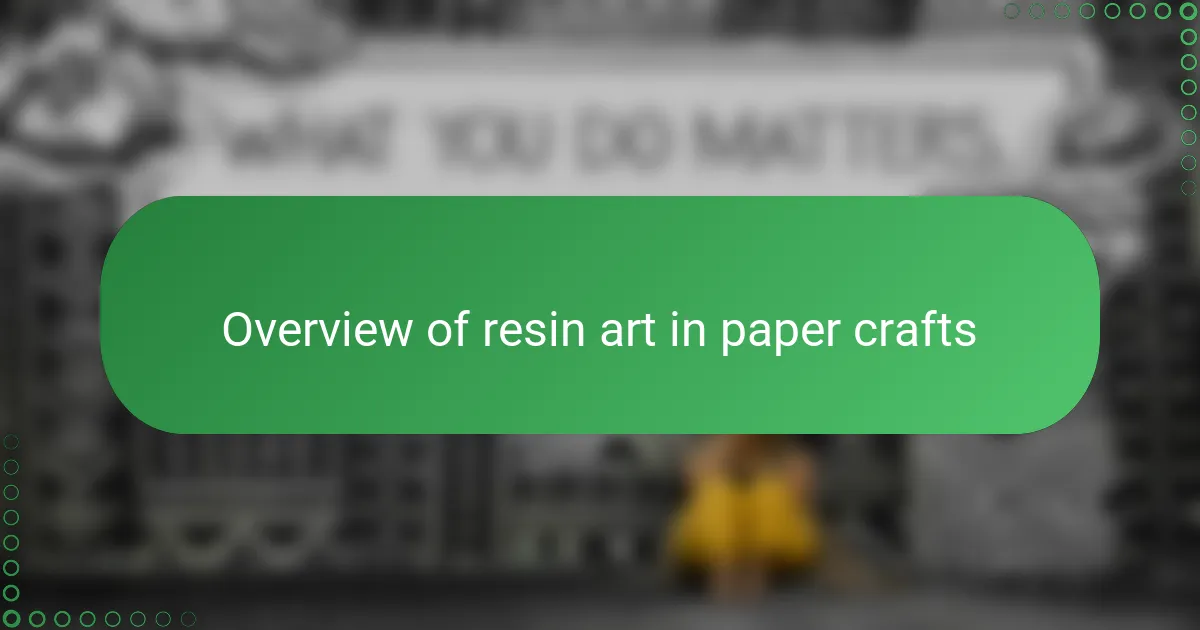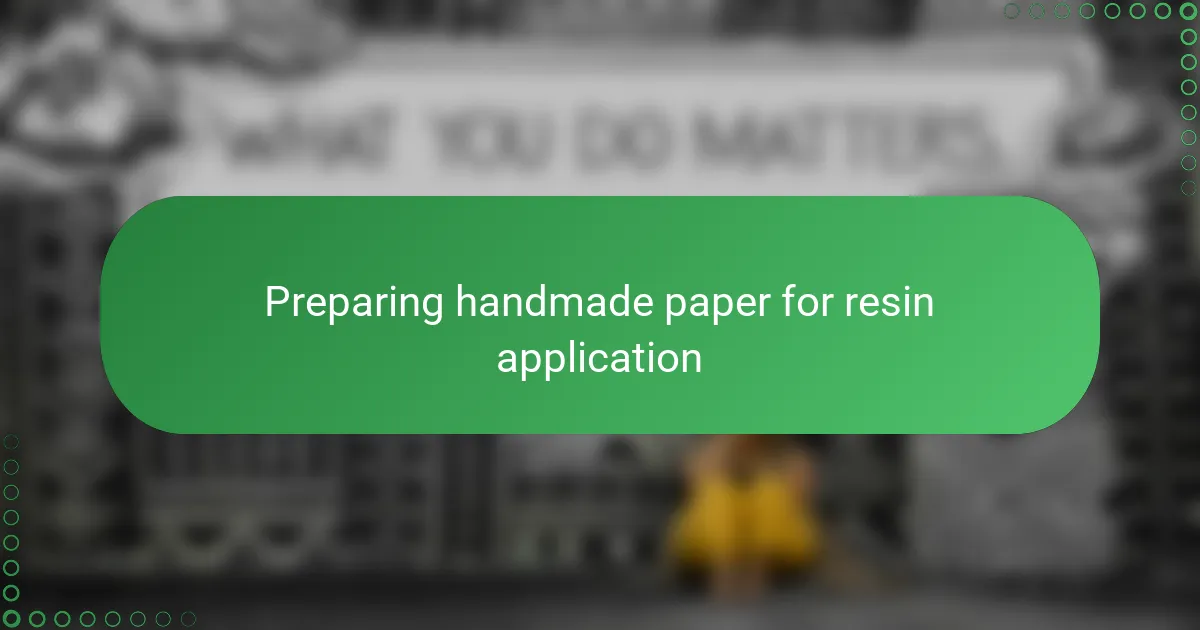Key takeaways
- Handmade paper crafts offer a unique emotional connection that mass-produced items lack, celebrating creativity through imperfections.
- Incorporating resin enhances the durability and visual appeal of paper crafts while requiring precise measurement and safety precautions.
- Choosing the right flexible resin and properly preparing the paper are crucial steps to prevent damage and ensure vibrant finishes.
- A dust-free workspace and controlled temperature are essential for achieving flawless resin finishes, and patience is key during the curing process.

Introduction to handmade paper crafts
Handmade paper crafts have this unique charm that machine-made products just can’t replicate. There’s something deeply satisfying about feeling the texture of paper you’ve shaped with your own hands—have you ever noticed how it connects you to the creative process in such a tangible way?
When I first started working with handmade paper, I was amazed at how versatile it could be. From delicate cards to textured art pieces, each creation carries a bit of the maker’s personality. Don’t you think that adds an emotional layer that mass-produced items often miss?
Exploring handmade paper crafts has become more than just a hobby for me; it’s a way to slow down and appreciate the beauty in simple, tactile experiences. It’s fascinating how the imperfections in the paper celebrate its handmade nature, reminding me that creativity thrives in those little quirks.

Overview of resin art in paper crafts
Resin art has opened up a whole new dimension in my paper crafting journey. When I first combined resin with handmade paper, I was struck by how the glossy, glass-like finish could enhance textures and colors in ways I hadn’t imagined. Have you ever thought about how a simple layer of resin can transform a flat piece of paper into something almost three-dimensional?
One thing I’ve noticed is that resin adds durability to paper crafts, which was a game-changer for me. Handmade paper is delicate, but the resin coating creates a protective seal that lets me experiment without worrying about damage. It’s like giving my paper projects a second life that can withstand handling and time.
Working with resin does require patience and a bit of practice to master the right mix and pouring technique. But the satisfaction of seeing my paper art sealed under a smooth, shiny surface makes those initial learning curves completely worth it. Have you tried resin art yet, or does it sound a bit intimidating? From my experience, once you get the hang of it, it’s incredibly rewarding.

Essential resin art supplies explained
When I first gathered my resin art supplies, I realized how crucial having the right materials was to avoid frustration. Clear epoxy resin, for example, is the heart of the process—it’s what gives that beautiful glassy finish and protects the delicate paper beneath. Have you ever struggled with yellowing or cloudy surfaces? Choosing a high-quality, UV-resistant resin made all the difference in keeping my creations vibrant over time.
Another must-have in my resin toolkit has been accurate measuring cups and mixing sticks. It might sound simple, but getting the resin-to-hardener ratio just right is key to avoiding sticky messes or slow curing. I remember the first time I eyeballed it and ended up with a tacky disaster. That taught me to embrace precision, which now feels like second nature.
Finally, safety gear like gloves and a well-ventilated space became non-negotiable as I worked more with resin. The chemicals can be a bit intimidating at first, but wearing gloves and using a mask helped me stay comfortable and focused. Have you ever hesitated starting resin art because of those fumes? Taking these precautions was a small step that gave me confidence to keep exploring and experimenting.

Choosing resin for paper projects
Choosing the right resin for paper projects is something I learned the hard way. At first, I picked a standard resin without thinking about its flexibility or curing time. That led to some cracking once the paper dried, which was frustrating. Have you ever faced that disappointment when your hard work seemed ruined by a technical detail?
From my experience, opting for a resin specifically labeled as flexible or designed for delicate substrates like paper makes a huge difference. It gently encapsulates the paper without stressing or warping it, preserving all that delicate texture I love. This choice gave me confidence to try bolder designs, knowing the resin wouldn’t compromise my paper’s integrity.
Another key factor I discovered is the resin’s clarity and UV resistance. I wanted my paper’s natural colors to shine through without turning yellow over time—a common issue I noticed in earlier experiments. Investing in a high-quality, crystal-clear resin that resists sunlight preserved the vibrancy of my projects, making each piece feel alive longer. Doesn’t it feel great when your art stays just as fresh as the day you made it?

Preparing handmade paper for resin application
Preparing handmade paper for resin application is where my careful attention really begins. I learned pretty quickly that the paper needs to be completely dry and flat—any wrinkles or moisture can cause bubbles or uneven curing. Have you ever tried sealing damp paper? The bubbling was a discouraging surprise that taught me to always let my sheets rest fully before starting.
I also like to gently sand the surface of my handmade paper with fine-grit sandpaper. It sounds counterintuitive, but this slight texture helps the resin adhere better without soaking in too much. At first, I was nervous about altering the paper’s delicate feel, but this step actually made my finishes smoother and more durable, which was a nice surprise.
Finally, I always wipe the paper down with a lint-free cloth to remove dust before pouring resin. It’s a simple habit that saved me from frustrating imperfections more times than I can count. Do you find that these small prep rituals add to your anticipation, making the moment you pour resin onto your paper feel a little more special? For me, they definitely set the stage for success.

My step-by-step resin art process
When I start my resin art process, the very first step is carefully measuring and mixing the resin and hardener exactly as the instructions say. I’ve learned the hard way that even a slight imbalance can mean a sticky, unusable mess. Have you ever noticed how precision turns a nervous experiment into a smooth, confident pour?
Next comes the moment I pour the resin over my prepared handmade paper. I take a deep breath because this is where anticipation mixes with a bit of anxiety—what if bubbles appear or the layer isn’t even? I found that pouring slowly from one corner and gently tilting the piece helps the resin spread out beautifully without trapping unwanted air.
After pouring, patience becomes my closest friend as I wait for the resin to cure. This drying phase feels like watching a slow magic unfold; the resin gradually turns from liquid to that perfect glossy finish that brings my paper craft to life. Have you experienced that quiet thrill when you uncover the hardened surface, knowing all your careful steps came together? It’s a rewarding moment every time.

Tips for successful resin paper crafts
One of the biggest lessons I’ve learned is to work in a dust-free environment. Even the tiniest specks can get trapped in the resin, and that’s something I didn’t expect to be so frustrating at first. Have you ever had a perfect pour ruined by a stray fiber? Now, I always clean my workspace thoroughly before starting—it makes all the difference in achieving that flawless finish.
Another tip that changed my game was controlling the temperature of the room. I noticed when it’s too cold, the resin thickens and traps bubbles, and when it’s too warm, it cures too fast, making it harder to work with. Finding that sweet spot around 70-75°F really helped me pour more smoothly and get consistent results I’m proud of.
Finally, patience is everything in resin paper crafts. Rushing the curing process or touching the surface too soon always caused problems for me. I try to remind myself that waiting those extra hours is part of the process—a moment to step back and let the resin work its magic. Have you ever struggled with impatience in your crafts? Trust me, the reward of a perfectly cured, glassy surface is always worth it.
